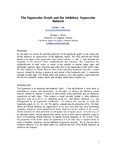- DSpace Home
- →
- Channel Islands
- →
- Academic Affairs
- →
- Faculty Scholarly and Creative Activities
- →
- Wolfe, William J.
JavaScript is disabled for your browser. Some features of this site may not work without it.
| dc.contributor.author | Wolfe, William | en |
| dc.contributor.author | Wolfe, William | en |
| dc.date.accessioned | 2007-08-04 | en |
| dc.date.accessioned | 2007-08-04 | en |
| dc.date.available | 2007-08-04 | en |
| dc.date.available | 2007-08-04 | en |
| dc.date.issued | 2007-08-04 | en |
| dc.date.issued | 2007-08-04 | en |
| dc.identifier.uri | http://hdl.handle.net/10139/418 | en |
| dc.identifier.uri | http://hdl.handle.net/10139/418 | en |
| dc.description | Submitted to the Journal of Graph Theory, 1/07. | en |
| dc.description | Submitted to the Journal of Graph Theory, 1/07. | en |
| dc.description.abstract | In this paper we review the spectral properties of the hypercube graph Qn and derive the Walsh functions as eigenvectors of the adjacency matrix. We then interpret the Walsh functions as states of the hypercube, with vertices labeled +1 and -1, and elucidate the regularity of the induced vertex neighborhoods and subcubes. We characterize the neighborhoods of each vertex in terms of the number of similar (same sign) and dissimilar (opposite sign) neighbors and relate that to the eigenvalue of the Walsh state. We then interpret the Walsh states as states of the inhibitory hypercube network, a neural network created by placing a neuron at each corner of the hypercube and -1 connection strength on each edge. The Walsh states with positive, zero, and negative eigenvalues are shown to be unstable, weakly stable, and strongly stable states, respectively. | en |
| dc.description.abstract | In this paper we review the spectral properties of the hypercube graph Qn and derive the Walsh functions as eigenvectors of the adjacency matrix. We then interpret the Walsh functions as states of the hypercube, with vertices labeled +1 and -1, and elucidate the regularity of the induced vertex neighborhoods and subcubes. We characterize the neighborhoods of each vertex in terms of the number of similar (same sign) and dissimilar (opposite sign) neighbors and relate that to the eigenvalue of the Walsh state. We then interpret the Walsh states as states of the inhibitory hypercube network, a neural network created by placing a neuron at each corner of the hypercube and -1 connection strength on each edge. The Walsh states with positive, zero, and negative eigenvalues are shown to be unstable, weakly stable, and strongly stable states, respectively. | en |
| dc.language.iso | en | en |
| dc.language.iso | en | en |
| dc.title | The Hypercube Graph & Inhibitory Networks | en |
| dc.title | The Hypercube Graph & Inhibitory Networks | en |
| dc.type | Preprint | en |
| dc.type | Preprint | en |

